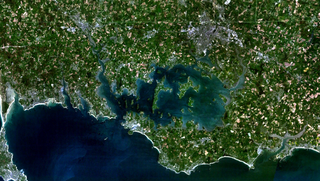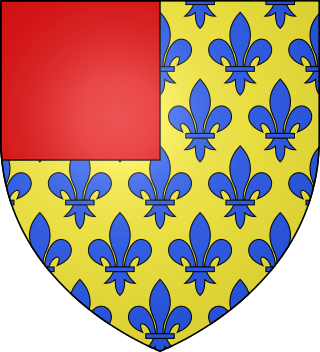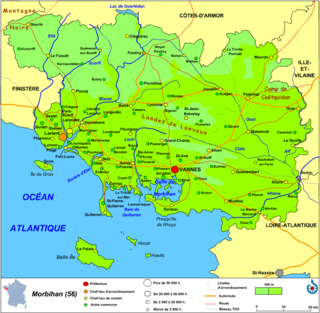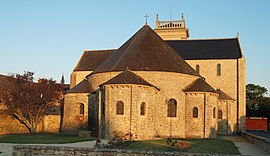
Gildas — also known as Gildas Badonicus, Gildas fab Caw and Gildas Sapiens — was a 6th-century British monk best known for his scathing religious polemic De Excidio et Conquestu Britanniae, which recounts the history of the Britons before and during the coming of the Saxons. He is one of the best-documented figures of the Christian church in the British Isles during the sub-Roman period, and was renowned for his Biblical knowledge and literary style. In his later life, he emigrated to Brittany, where he founded a monastery known as Saint-Gildas-de-Rhuys.

The Gulf of Morbihan is a natural harbour on the coast of the department of Morbihan in southern Brittany, France. Its English name is taken from the French version, le golfe du Morbihan, though it would be more precisely called 'the Morbihan' as its Breton name 'Ar Mor Bihan' means 'the little sea'., as opposed to the Atlantic Ocean outside,. Legend says that there are as many islands in the Gulf as there are days of the year. In fact the gulf has about 40, depending on the tides. Many islands are private property, except the largest two, Île-aux-Moines and Île-d'Arz.

Guy of Thouars was the third husband of Constance, Duchess of Brittany, whom he married in Angers, County of Anjou between August and October 1199 after her son Arthur of Brittany entered Angers to be recognized as count of the three countships of Anjou, Maine and Touraine. He was an Occitan noble, a member of the House of Thouars. He is counted as a duke of Brittany, jure uxoris, from 1199 to 1201.

Hœdic or Hoëdic is an island off the south coast of Brittany in northwestern France. Its bigger "twin sister" island is Houat.

Île-d'Arz is an archipelago of nine islands and a commune in the Morbihan department, Brittany, northwestern France, only 6 kilometres to the southwest of Vannes.

The arrondissement of Vannes is an arrondissement of France in the Morbihan department in the Brittany region. It has 99 communes. Its population is 279,964 (2016), and its area is 2,416.2 km2 (932.9 sq mi).

Île-aux-Moines is a commune in the Morbihan department in the region of Brittany in northwestern France.

Sarzeau is a commune in the Morbihan department of Brittany in north-western France.

Ploërdut is a commune in the Morbihan department in Brittany in north-western France.

Pluvigner is a commune in the Morbihan department of Brittany in north-western France.

La Vraie-Croix is a commune in the Morbihan department in Brittany in north-western France. Its inhabitants are called Langroëziens after the Breton name for the commune.

Saint-Jacut-les-Pins is a commune in the Morbihan department of Brittany in north-western France.
Saint Felix of Rhuys was a Breton Benedictine hermit and abbot, who re-founded Saint-Gildas-de-Rhuys Abbey.

The Rhuys Peninsula is located in the département of Morbihan in the region of Brittany in northwestern France.

Poher is an ancient principality that emerged in the Early Middle Ages in Cornouaille in west-central Brittany. Its capital was the Gallo-Roman city of Vorgium, capital of the Osismii, which became Carhaix after the fall of the Roman Empire. Archaeological excavations scheduled since 1999 show that, even if the city lost its function as capital after the 4th century, it was nonetheless a stronghold and major strategic crossroads.
The canton of Séné is an administrative division of the Morbihan department, northwestern France. It was created at the French canton reorganisation which came into effect in March 2015. Its seat is in Séné.
Golfe du Morbihan - Vannes Agglomération is the communauté d'agglomération, an intercommunal structure, centred on the city of Vannes. It is located in the Morbihan department, in the Brittany region, northwestern France. It was created in January 2017 by the merger of the former Communauté d'agglomération Vannes Agglo with the former communautés de communes Loc'h Communauté and Presqu'île de Rhuys. Its area is 807.4 km2. Its population was 169,785 in 2018, of which 53,438 in Vannes proper.
Olivier Delourme (1660–1729), nicknamed "the architect of Brittany", was a French architect of the "Grand Siècle" renowned for his many achievements still existing, mainly in Morbihan.

Prières Abbey is a former Cistercian monastery in the commune of Billiers in the department of Morbihan, Brittany, France, about 28 kilometres southeast of Vannes near the coast and the mouth of the River Vilaine.

Saint Bieuzy was a 6th-century Breton hermit and companion of Saint Gildas who gave his name to the villages of Bieuzy and Bieuzy-Lanvaux, both in Morbihan. His name probably comes from the Old Breton biu, bihui, "living". His feast day is 24 November.




















